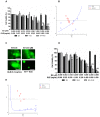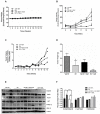Ganoderma lucidum Combined with the EGFR Tyrosine Kinase Inhibitor, Erlotinib Synergize to Reduce Inflammatory Breast Cancer Progression
- PMID: 26958085
- PMCID: PMC4780125
- DOI: 10.7150/jca.13599
Ganoderma lucidum Combined with the EGFR Tyrosine Kinase Inhibitor, Erlotinib Synergize to Reduce Inflammatory Breast Cancer Progression
Abstract
The high incidence of resistance to Tyrosine Kinase Inhibitors (TKIs) targeted against EGFR and downstream pathways has increased the necessity to identify agents that may be combined with these therapies to provide a sustained response for breast cancer patients. Here, we investigate the therapeutic potential of Ganoderma lucidum extract (GLE) in breast cancer, focusing on the regulation of the EGFR signaling cascade when treated with the EGFR TKI, Erlotinib. SUM-149, or intrinsic Erlotinib resistant MDA-MB-231 cells, and a successfully developed Erlotinib resistant cell line, rSUM-149 were treated with increasing concentrations of Erlotinib, GLE, or their combination (Erlotinib/GLE) for 72h. Treatment effects were tested on cell viability, cell proliferation, cell migration and invasion. To determine tumor progression, severe combined immunodeficient mice were injected with SUM-149 cells and then treated with Erlotinib/GLE or Erlotinib for 13 weeks. We assessed the protein expression of ERK1/2 and AKT in in vitro and in vivo models. Our results show that GLE synergizes with Erlotinib to sensitize SUM-149 cells to drug treatment, and overcomes intrinsic and developed Erlotinib resistance. Also, Erlotinib/GLE decreases SUM-149 cell viability, proliferation, migration and invasion. GLE increases Erlotinib sensitivity by inactivating AKT and ERK signaling pathways in our models. We conclude that a combinatorial therapeutic approach may be the best way to increase prognosis in breast cancer patients with EGFR overexpressing tumors.
Keywords: EGFR; Erlotinib; Ganoderma lucidum; drug resistance.; synergy.
Conflict of interest statement
Conflict of interest: The authors declare that they have no conflict of interest.
Figures





Similar articles
-
Focal Adhesion Kinase Inhibitors in Combination with Erlotinib Demonstrate Enhanced Anti-Tumor Activity in Non-Small Cell Lung Cancer.PLoS One. 2016 Mar 10;11(3):e0150567. doi: 10.1371/journal.pone.0150567. eCollection 2016. PLoS One. 2016. PMID: 26962872 Free PMC article.
-
Ganoderma lucidum Extract Reduces the Motility of Breast Cancer Cells Mediated by the RAC⁻Lamellipodin Axis.Nutrients. 2019 May 19;11(5):1116. doi: 10.3390/nu11051116. Nutrients. 2019. PMID: 31109134 Free PMC article.
-
Network pharmacology analysis of the anti-cancer pharmacological mechanisms of Ganoderma lucidum extract with experimental support using Hepa1-6-bearing C57 BL/6 mice.J Ethnopharmacol. 2018 Jan 10;210:287-295. doi: 10.1016/j.jep.2017.08.041. Epub 2017 Sep 4. J Ethnopharmacol. 2018. PMID: 28882624
-
Combination of BIBW2992 and ARQ 197 is effective against erlotinib-resistant human lung cancer cells with the EGFR T790M mutation.Oncol Rep. 2014 Jul;32(1):341-7. doi: 10.3892/or.2014.3178. Epub 2014 May 15. Oncol Rep. 2014. PMID: 24842595
-
Ganoderma lucidum enhances carboplatin chemotherapy effect by inhibiting the DNA damage response pathway and stemness.Am J Cancer Res. 2022 Mar 15;12(3):1282-1294. eCollection 2022. Am J Cancer Res. 2022. PMID: 35411244 Free PMC article.
Cited by
-
Syndecan-1 is a novel molecular marker for triple negative inflammatory breast cancer and modulates the cancer stem cell phenotype via the IL-6/STAT3, Notch and EGFR signaling pathways.Mol Cancer. 2017 Mar 7;16(1):57. doi: 10.1186/s12943-017-0621-z. Mol Cancer. 2017. PMID: 28270211 Free PMC article.
-
Mycochemicals against Cancer Stem Cells.Toxins (Basel). 2023 May 25;15(6):360. doi: 10.3390/toxins15060360. Toxins (Basel). 2023. PMID: 37368660 Free PMC article. Review.
-
Anticancer and Antioxidant Activities in Ganoderma lucidum Wild Mushrooms in Poland, as Well as Their Phenolic and Triterpenoid Compounds.Int J Mol Sci. 2022 Aug 19;23(16):9359. doi: 10.3390/ijms23169359. Int J Mol Sci. 2022. PMID: 36012645 Free PMC article.
-
Anti-Cancer Potential of Edible/Medicinal Mushrooms in Breast Cancer.Int J Mol Sci. 2023 Jun 14;24(12):10120. doi: 10.3390/ijms241210120. Int J Mol Sci. 2023. PMID: 37373268 Free PMC article. Review.
-
SCAMP3 Regulates EGFR and Promotes Proliferation and Migration of Triple-Negative Breast Cancer Cells through the Modulation of AKT, ERK, and STAT3 Signaling Pathways.Cancers (Basel). 2022 Jun 5;14(11):2807. doi: 10.3390/cancers14112807. Cancers (Basel). 2022. PMID: 35681787 Free PMC article.
References
-
- Dawood S, Ueno NT, Valero V, Woodward WA, Buchholz TA, Hortobagyi GN. et al. Differences in survival among women with stage III inflammatory and noninflammatory locally advanced breast cancer appear early: a large population-based study. Cancer. 2011;117:1819–26. - PubMed
-
- Walker R. Rosen's Breast Pathology. J Clin Pathol. 1997;50:1036.
-
- Cabioglu N, Gong Y, Islam R, Broglio KR, Sneige N, Sahin A. et al. Expression of growth factor and chemokine receptors: new insights in the biology of inflammatory breast cancer. Annals of oncology: official journal of the European Society for Medical Oncology / ESMO. 2007;18:1021–9. - PubMed
-
- Yamauchi H, Ueno NT. Targeted therapy in inflammatory breast cancer. Cancer. 2010;116:2758–9. - PubMed
Grants and funding
LinkOut - more resources
Full Text Sources
Other Literature Sources
Molecular Biology Databases
Research Materials
Miscellaneous

